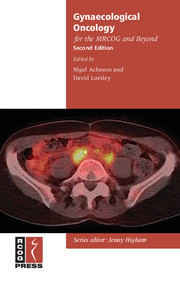Book contents
- Frontmatter
- Contents
- About the authors
- Preface
- Introduction to the second edition
- Abbreviations
- 1 Basic epidemiology
- 2 Basic pathology of gynaecological cancer
- 3 Preinvasive disease of the lower genital tract
- 4 Radiological assessment
- 5 Surgical principles
- 6 Role of laparoscopic surgery
- 7 Radiotherapy: principles and applications
- 8 Chemotherapy: principles and applications
- 9 Ovarian cancer standards of care
- 10 Endometrial cancer standards of care
- 11 Cervical cancer standards of care
- 12 Vulval cancer standards of care
- 13 Uncommon gynaecological cancers
- 14 Palliative care
- 15 Emergencies and treatment-related complications in gynaecological oncology
- Appendix 1 FIGO staging of gynaecological cancers
- Index
6 - Role of laparoscopic surgery
Published online by Cambridge University Press: 05 August 2014
- Frontmatter
- Contents
- About the authors
- Preface
- Introduction to the second edition
- Abbreviations
- 1 Basic epidemiology
- 2 Basic pathology of gynaecological cancer
- 3 Preinvasive disease of the lower genital tract
- 4 Radiological assessment
- 5 Surgical principles
- 6 Role of laparoscopic surgery
- 7 Radiotherapy: principles and applications
- 8 Chemotherapy: principles and applications
- 9 Ovarian cancer standards of care
- 10 Endometrial cancer standards of care
- 11 Cervical cancer standards of care
- 12 Vulval cancer standards of care
- 13 Uncommon gynaecological cancers
- 14 Palliative care
- 15 Emergencies and treatment-related complications in gynaecological oncology
- Appendix 1 FIGO staging of gynaecological cancers
- Index
Summary
Introduction
The first decade of the 21st century has seen minimal access surgery in oncology progress from simple laparoscopically assisted vaginal procedures to complex operations such as radical hysterectomy and lymph node dissection. Laparoscopic surgery is associated with reduced levels of postoperative pain, early discharge from hospital and an earlier return to normal activity. However, many surgeons have been reluctant to replace abdominal radical surgery with laparoscopic surgery because of concerns that it does not replicate the radicalism of open surgery. In 1987, Dargent reported combining a radical vaginal hysterectomy with a laparoscopic pelvic lymph node dissection in the management of cervical cancer. Following this, a number of reports have been published on the feasibility and safety of laparoscopic surgery in treating gynaecological cancer. More recently, new energy modalities, such as the argon beam coagulator and the harmonic scalpel, have allowed safe dissection of tissue with minimal thermal spread to nearby structures.
Cervical cancer
The management of cervical cancer is based on the extent of disease spread using the FIGO staging system. This is based on clinical examination and limited radiological assessment. Clinical staging allows only limited assessment of the nodal status, which is considered one of the most important prognostic factors.
Keywords
- Type
- Chapter
- Information
- Gynaecological Oncology for the MRCOG and Beyond , pp. 83 - 94Publisher: Cambridge University PressPrint publication year: 2011

